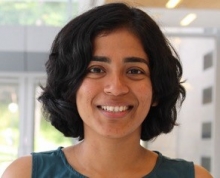CBE Seminar (Zoom): Engineering Solar Devices for Hydrogen Production and Wastewater Resource Recovery

University of Michigan, Ann Arbor, MI
Registration Link: https://forms.gle/skUWevmgZDaBVMFH8
Abstract: Understanding the complex coupling of mass, momentum, energy, charge and radiative transport, and chemical reactions is crucial to boost the materials-to-device scale performance of a host of solar energy technologies. In this talk, I will discuss solar processes for two main applications: (a) renewable fuels production, and (b) the transformation of wastewater contaminants to value-added fuels, fertilizers and chemicals. Solar-fuel technologies offer the potential to harness and store sunlight in the form of energy dense chemicals such as hydrogen and hydrocarbon compounds, derived from water and carbon dioxide. Z-scheme photocatalytic particles in an aqueous solution with soluble redox shuttles and present in vertically stacked reaction compartments present a promising pathway for solar water splitting to produce hydrogen. In recent work, we theoretically demonstrated the feasibility of attaining up to 4% solar-to-hydrogen efficiencies with state-of-the-art photocatalysts and redox shuttles with passive diffusion-driven species transport. To attain larger solar-to-hydrogen efficiencies, it is crucial to achieve selective and functional interfaces that can inhibit undesired reactions of the redox shuttle, and enhanced rates of redox shuttle transport between the two reaction compartments. I will elaborate on the development of a multiscale model-based approach, supplemented with experiments, to evaluate the coupled effects of light absorption, species transport, reaction kinetics and heat transfer on the overall performance. Next, I will report on the developments of a new approach to harness sunlight to transform wastewater nitrate contaminants to ammonia, coupled with water oxidation. We have developed numerical models to quantify the dependence of process efficiencies and nitrogen-removal rates on pertinent materials, and device design and operational parameters. Theoretically predicted peak nitrogen removal rates and specific energy intensities are competitive with reported estimates for electrochemical and Sharon−Anammox processes for ammonia recovery and nitrogen removal, respectively. Finally, a discussion of central challenges and future research needs pertinent to both these applications will be included.
|
|
|
Bio: Rohini Bala Chandran is an assistant professor in mechanical engineering at the University of Michigan since January 2018. Previously, she was a postdoctoral research fellow at Lawrence Berkeley National Lab and obtained a master's degree (2010) and doctorate (2015) from the University of Minnesota, Twin Cities, in mechanical engineering. At Michigan, Bala Chandran leads the Transport and Reaction Engineering for Sustainable Energy Lab (TREE Lab), where she and her students perform multidisciplinary research in the areas of thermal and fluid sciences, multiscale computational modeling, electrochemical engineering and semiconductor physics. Bala Chandran was recently selected as a participant for the 2020 U.S. Frontiers of Engineering Symposium organized by the National Academy of Engineering. Research in her group is funded by the U.S. Advanced Research Projects Agency – Energy (ARPA-E), U.S. Department of Energy Fuel Cell Technologies Office (DOE-FCTO), and startup funding from the University of Michigan, Ann Arbor.
